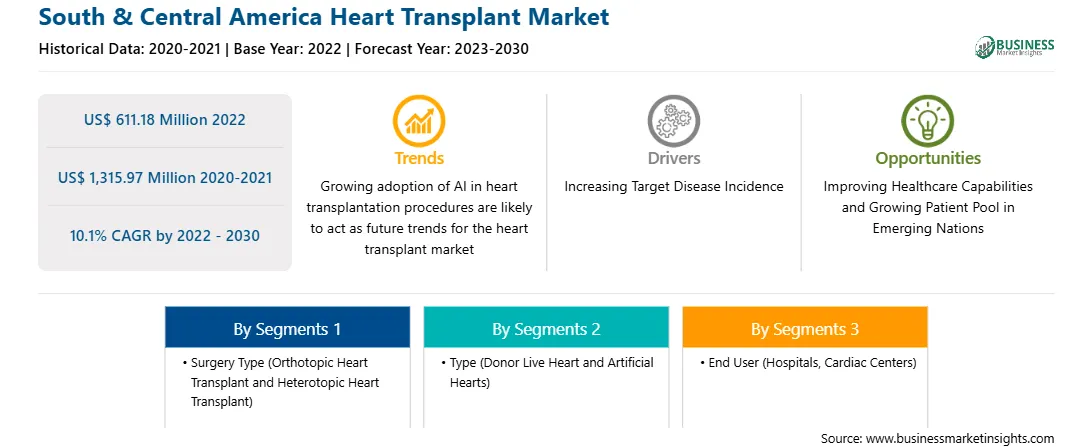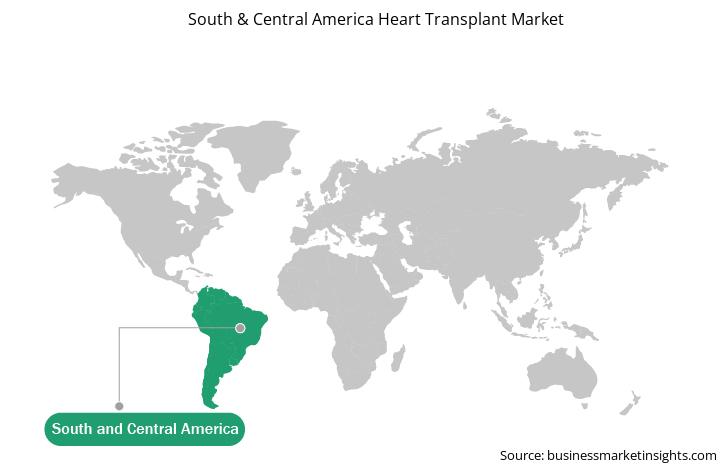The South & Central America heart transplant market is expected to grow from US$ 611.18 million in 2022 to US$ 1,315.97 million by 2030. It is estimated to grow at a CAGR of 10.1% from 2022 to 2030.
A uniquely designed system backed by artificial intelligence (AI) facilitates the detection of early signs and seriousness of the host rejection post-heart transplantation. The endomyocardial biopsy (EMB) screening signifies the standard of care for identifying allograft rejections after a heart transplant. In 2022, a new AI system was designed known as the Cardiac Rejection Assessment Neural Estimator (CRANE), which can be used in tandem with medical assessments for rapid and precise diagnosis. CRANE also helps reduce differences regarding the presence and severity of heart rejection in the host body. It is a deep learning-based AI system for the automated assessment of gigapixel whole-slide images obtained from EMBs. In 2020, the National Institute of Health granted US$ 3.2 million to studies based on the exploration of the capabilities of AI in heart transplants. With this grant, researchers from Perelman School of Medicine (the University of Pennsylvania), Case Western Reserve University, Cleveland Clinic, and Cedars-Sinai Medical Center aimed to study what causes the rejection of a new heart and how to manage it. They used AI to analyze cardiac biopsy tissue images, finding the types of immune cells that play an instrumental role in new heart rejection. Thus, the adoption of AI in heart transplantation procedures is likely to bring new trends in the market in the coming years.
The heart transplant market in South & Central America is sub segmented into Brazil, Argentina, and the Rest of South & Central America. Developing healthcare facilities, increasing incidence of hypertension, a rise in the geriatric population, and the surging incidence of kidney and heart diseases are the factors that are expected to fuel the heart transplant market in South & Central America. More than half of the rejections (59%) were due to the clinical conditions of the donors, including old age, comorbidities, and infections. According to the Brazilian government, from January to November 2021, more than 12,000 organ transplants were performed in Brazil. Children were also severely affected. In 2022, 583 children aged 0-17 years were operated on for organ transplantation, same as that in 2021. ~641 new children entered the waiting list, and 66 died while waiting for an organ.

Strategic insights for the South & Central America Heart Transplant provides data-driven analysis of the industry landscape, including current trends, key players, and regional nuances. These insights offer actionable recommendations, enabling readers to differentiate themselves from competitors by identifying untapped segments or developing unique value propositions. Leveraging data analytics, these insights help industry players anticipate the market shifts, whether investors, manufacturers, or other stakeholders. A future-oriented perspective is essential, helping stakeholders anticipate market shifts and position themselves for long-term success in this dynamic region. Ultimately, effective strategic insights empower readers to make informed decisions that drive profitability and achieve their business objectives within the market.

| Report Attribute | Details |
|---|---|
| Market size in 2022 | US$ 611.18 Million |
| Market Size by 2030 | US$ 1,315.97 Million |
| Global CAGR (2022 - 2030) | 10.1% |
| Historical Data | 2020-2021 |
| Forecast period | 2023-2030 |
| Segments Covered |
By Surgery Type
|
| Regions and Countries Covered | South and Central America
|
| Market leaders and key company profiles |
The geographic scope of the South & Central America Heart Transplant refers to the specific areas in which a business operates and competes. Understanding local distinctions, such as diverse consumer preferences (e.g., demand for specific plug types or battery backup durations), varying economic conditions, and regulatory environments, is crucial for tailoring strategies to specific markets. Businesses can expand their reach by identifying underserved areas or adapting their offerings to meet local demands. A clear market focus allows for more effective resource allocation, targeted marketing campaigns, and better positioning against local competitors, ultimately driving growth in those targeted areas.

The South & Central America heart transplant market is segmented into surgery type, type, end user, and country.
Based on surgery type, the South & Central America heart transplant market is bifurcated into orthotopic heart transplantation and heterotopic heart transplantation. The orthotopic heart transplantation segment held a larger share of the South & Central America heart transplant market in 2022.
In terms of type, the South & Central America heart transplant market is bifurcated into donor live heart and artificial heart. The donor live heart segment held a larger share of the South & Central America heart transplant market in 2022. Further, artificial heart segment is categorized into ventricular assisted device and total artificial heart.
Based on end user, the South & Central America heart transplant market is segmented into hospitals, cardiac centers, and others. The hospitals segment held the largest share of the South & Central America heart transplant market in 2022.
Based on country, the South & Central America heart transplant market is segmented into Brazil, Argentina, and the Rest of South & Central America. Brazil dominated the South & Central America heart transplant market in 2022.
Terumo Corp, Abbott Laboratories, SynCardia Systems LLC, LivaNova Plc, and Calon Cardio-Technology Ltd are some of the leading companies operating in the South & Central America heart transplant market.
1. Terumo Corp
2. Abbott Laboratories
3. SynCardia Systems LLC
4. LivaNova Plc
The South & Central America Heart Transplant Market is valued at US$ 611.18 Million in 2022, it is projected to reach US$ 1,315.97 Million by 2030.
As per our report South & Central America Heart Transplant Market, the market size is valued at US$ 611.18 Million in 2022, projecting it to reach US$ 1,315.97 Million by 2030. This translates to a CAGR of approximately 10.1% during the forecast period.
The South & Central America Heart Transplant Market report typically cover these key segments-
The historic period, base year, and forecast period can vary slightly depending on the specific market research report. However, for the South & Central America Heart Transplant Market report:
The South & Central America Heart Transplant Market is populated by several key players, each contributing to its growth and innovation. Some of the major players include:
The South & Central America Heart Transplant Market report is valuable for diverse stakeholders, including:
Essentially, anyone involved in or considering involvement in the South & Central America Heart Transplant Market value chain can benefit from the information contained in a comprehensive market report.